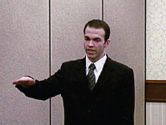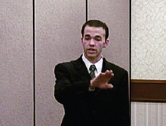SAMPLE VISUALLY ANNOTATED INFORMATIVE SPEECH
John Kanzius and the Quest to Cure Cancer
DAVID KRUCKENBERG
Santiago Canyon College
The following speech by student David Kruckenberg describes a promising new way to treat cancer. David clarifies information with definitions and analogies and uses transitions and repetition to help listeners follow along. He also cites sources wherever he offers information gathered and reported by others.
David’s topic could suggest a chronological pattern of arrangement. For example, he could have arranged his main points to trace the invention from inception to ongoing trials. Instead, he uses the topical pattern of arrangement (see Chapter 12) to move back and forth between describing the history of the new cancer treatment and explaining key concepts related to it.
 Telling a story is an effective means of gaining the audience’s attention.
Telling a story is an effective means of gaining the audience’s attention.
One night in 2003, Marianne Kanzius awoke to a tremendous clamor coming from downstairs. She found her husband John sitting on the kitchen floor, cutting up her good aluminum pie pans with a pair of shears. 
 David artfully weaves a source citation into the narrative.
David artfully weaves a source citation into the narrative.
As journalist Peter Panepento describes the scene in an article published back in the May 2006 edition of Reader’s Digest,1 when Marianne asked John why he was wiring the pans to his ham radio, John told her to go back to bed. 
So off she went, knowing that her single-minded husband, a successful broadcast engineer, station owner, and inventor, wasn’t the kind of person to quit until he was satisfied.

 Here David states his thesis.
Here David states his thesis.
Of course, Marianne learned soon enough what John’s late-night experiment with pie pans was about. Her husband, only recently retired, was trying to use radio waves to kill cancer cells—and to rid himself of the rare form of leukemia threatening his life. In the next three years, until his death in 2009, John Kanzius, shown here, would radically modify an existing cancer treatment technique called radiofrequency ablation, making it potentially far more effective than existing treatments. 
John lived just long enough to establish a research center in his name—now the thriving Kanzius Cancer Research Foundation—and to see the publication of two important research studies validating his ideas. Soon, he believed, researchers would achieve the necessary refinements to help the 1.4 million Americans diagnosed with cancer every year, according to the 2013 American Cancer Society “Facts and Figures” section of its website.2

 Here David previews the main points.
Here David previews the main points.
To understand John’s discovery, we’ll explore how the medical profession currently makes use of radio waves to treat cancer, learn about John’s truly promising new approach, and consider the implications for the future. 
But first, to understand radiofrequency energy, we need a crash course in wave physics.

 David helps listeners understand the concept of frequency by offering an analogy.
David helps listeners understand the concept of frequency by offering an analogy.
Energy moves in a wave and is measured in frequency, how quickly it moves up and down. High-frequency waves, like Superman’s X-ray vision—and real X-rays—move quickly and penetrate most matter, but can alter the chemical and genetic material in cells. 
Low-frequency waves, such as radio waves, move slowly and don’t disturb the atomic balance of matter they pass through. Radio waves are harmless to healthy cells, making them a promising tool for ablation.
 He is careful to define potentially confusing terms.
He is careful to define potentially confusing terms.
Let me explain the term.  Ablation, according to the National Cancer Institute’s Dictionary of Cancer Terms, available on its website,3 is the medical term for “the removal or destruction of a body part or tissue or its function,” using conventional surgery, drugs, or radiofrequency. As described by the Radiological Society of North America website,4 in radiofrequency ablation, imaging techniques such as ultrasound are used to help guide a needle electrode into a cancerous tumor. High-frequency electrical currents are then passed through the electrode, creating heat that destroys the abnormal cells. Here’s how the Radiological Society of North America explains the current practice of radiofrequency ablation on its website, last updated August 20, 2013.
Ablation, according to the National Cancer Institute’s Dictionary of Cancer Terms, available on its website,3 is the medical term for “the removal or destruction of a body part or tissue or its function,” using conventional surgery, drugs, or radiofrequency. As described by the Radiological Society of North America website,4 in radiofrequency ablation, imaging techniques such as ultrasound are used to help guide a needle electrode into a cancerous tumor. High-frequency electrical currents are then passed through the electrode, creating heat that destroys the abnormal cells. Here’s how the Radiological Society of North America explains the current practice of radiofrequency ablation on its website, last updated August 20, 2013.
 To help listeners follow his explanation, David uses signpost words such as “first” and “next.”
To help listeners follow his explanation, David uses signpost words such as “first” and “next.”
First, a doctor makes a small incision in the skin and inserts a needle electrode or a straight hollow needle containing retractable electrodes. 
The doctor guides the needle to the site of the tumor using an imaging technique such as ultrasound.
The needle in turn is connected to an electric generator, and once in place, electrodes extend out of it and into the tumor.
 David’s mosh-pit analogy helps listeners understand a complex concept.
David’s mosh-pit analogy helps listeners understand a complex concept.
Next, contact pads, also wired to the generator, are placed on the patient’s skin; this completes an electric circuit so that when the generator is turned on, electric energy in the form of radio waves passes through the body, going back and forth between the needles and the contact pads.
Here’s the critical part: Every time that the radio waves meet the resistance of the electrodes at the treatment site, they create heat. It’s kind of like an atomic mosh pit, with a crowd of atoms suddenly agitated by radio waves; the electrons begin to bounce around and collide, creating friction and thus heat. 
The heat destroys the cancerous cells in the tumor, essentially cooking them, but leaving noncancerous cells alone.
Radiofrequency ablation or RFA is a great treatment option right now. However, while it is called “minimally invasive” surgery, the needle electrodes required by this method can damage tissue and even organs near the tumor site, limiting its usefulness. And, very importantly, it can only be used on certain types of small tumors.
 This short transition adds drama.
This short transition adds drama.
Enter John Kanzius. 
John’s ordeal with chemotherapy motivated him to find a better way to attack cancer cells. Even more, he was driven to help the cancer-ridden children he witnessed in the pediatric ward. As he told Peter Panepento in Reader’s Digest:
 David is careful to credit direct quotations.
David is careful to credit direct quotations.
When [the children] first came in, they looked strong, their complexions rosy. “They’d greet you with a grin. By the second treatment, that all faded. It was like watching an artist paint away the smiles . . . 
Now John had no medical training, but he knew all about radio waves. He recalled that years earlier a colleague wearing wire-rimmed glasses got burned as he stood too close to a radio transmitter. As Peter Panepento describes it in Reader’s Digest, this led Kanzius to theorize that if you could infuse cancer cells with a conductive substance, you could use a transmitter to heat them with radio waves, while avoiding the invasive needle electrode. The cells marked with the substance would act like “tiny antennas,” as Panepento put it.
It was this chain of thought which spurred John’s late-night kitchen experiment with the pie pans and his ham radio. 
 David uses helpful transitions.
David uses helpful transitions.
Two things were amazing about John’s initial experiment.
First, John was able to replicate RFA in his kitchen. Second, John made a huge improvement upon the existing RFA technique, alone and at home. Instead of inserting needles into a tumor, he injected tiny metal minerals into a stand-in hotdog. He then placed the hotdog between the radio transmitter and receiver so that the radio waves would pass through the meat. When he cut the hotdog open, the area around the minerals was cooked, but the rest remained raw. Kanzius later repeated the experiment with liver, then steak, obtaining the same results.
 Here, David uses a transition in the form of a rhetorical question.
Here, David uses a transition in the form of a rhetorical question.
Could there really be a way to use radiofrequency without side effects, and to treat many more types—or even every type—of cancer with it? 
As told by Charles Schmidt in the Journal of the National Cancer Institute on July 16, 2008,5 John shared his results with several leading oncologists, who immediately recognized the potential. He then filed for, and received, a patent for his radiofrequency transmitter machine.
 Because the size of a nanoparticle is hard to visualize, David uses an analogy, comparing it to something with which listeners are familiar—a strand of hair and dandruff.
Because the size of a nanoparticle is hard to visualize, David uses an analogy, comparing it to something with which listeners are familiar—a strand of hair and dandruff.
Researchers at two prominent cancer centers decided to test John’s theory, starting in August 2005 with the University of Pittsburgh’s Liver Cancer Center. As detailed in the University of Pittsburgh Medical Center newsletter of March 22, 2006,6 instead of using a hotdog, the researchers placed a thin test tube between the radio transmitter and the receiver. Inside this tube was a solution of carbon nanoparticles—actually pieces of metal about 1/75,000 times smaller than the width of a human hair. A speck of dandruff is like a mountain to a nanoparticle. 
When they turned on the electricity, the carbon nanoparticles successfully heated to 130 degrees Fahrenheit—the perfect temperature at which to kill cancer cells, according to Peter Panepento’s Reader’s Digest piece. Follow-up experiments showed that when exposed to radio waves, the nanoparticles generated bursts of heat that killed cancer cells while leaving adjacent cells unharmed.
 David uses a transition to alert listeners to what he will discuss next.
David uses a transition to alert listeners to what he will discuss next.
Now that I’ve explained John’s major improvement over current RFA procedures—that, at least in theory, you can use nanoparticles rather than electrodes to target cancer cells—let’s consider the implications of his discovery. 
John’s noninvasive radiofrequency cancer treatment holds tremendous promise as an alternative to existing cancer therapies. First, because RFA uses electromagnetic energy in the form of low-frequency radio waves, it’s much safer than chemotherapy and traditional radiation treatment. As noted, radio waves are harmless to healthy cells, as compared to X-rays.
 Proper acknowledgment of each source increases David’s credibility and allows the audience to seek further information on the topic.
Proper acknowledgment of each source increases David’s credibility and allows the audience to seek further information on the topic.
Second, as explained in the January 2008 issue of the Journal of Nanobiotechnology by Gannon et al.,7 the current RFA procedure can only be used in cancers that are not difficult to reach, such as liver, breast, lung, and bone; John’s new method potentially can target tumors anywhere in the body. 
According to the Kanzius Foundation website, which has partnered with cancer specialists at two of the top cancer centers in the world—the renowned M. D. Anderson Cancer Center in Houston and the University of Pittsburgh Medical Center—in October 2013 Dr. Steven Curley, of the M. D. Anderson Cancer Center, successfully used the Kanzius radiofrequency machine, now called the GenV Kanzius Device, to target cancer cells in pigs.
Of course, the goal has always been to get to human clinical trials.

 David shows a brief video clip.
David shows a brief video clip.
According to the Kanzius website, Dr. Curley announced plans to seek approval from the Food and Drug Administration for human trials beginning in 2015. In this brief video tour of the Kanzius lab at M. D. Anderson Cancer Center in Houston, posted on the Kanzius Center website, Dr. Curley offers an update of the latest development. 
 David signals the speech’s conclusion with a summary of the main points. A return to David’s opening story brings the speech full circle.
David signals the speech’s conclusion with a summary of the main points. A return to David’s opening story brings the speech full circle.
Today we learned how a man with vision discovered how to cook a hotdog with a ham radio. We explored first the current procedure, then John’s new approach, and, finally, the implications of this new hope for treating cancer. 
Marianne Kanzius was upset when she saw her husband destroying her good pie pans, but now it’s clear that the loss of a few pie pans and a hotdog may soon save millions of lives.
Works Cited
1. Panepento, Peter. “Sparks of Genius: Efforts Done by John Kanzius, a Cancer Patient, to Find a Better Cure for Cancer,” Reader’s Digest (May 2006): 132–36.
2. American Cancer Society. “Cancer Facts and Figures, 2013.” Accessed October 15, 2013, at www.cancer.org/research/cancerfactsstatistics/cancerfactsfigures2013/index.
3. National Cancer Institute, Dictionary of Cancer Terms, www.cancer.gov/dictionary?CdrID=44865, September 26, 2013.
4. Radiological Society of North America. “Radiofrequency Ablation of Kidney Tumors.” Updated August 20, 2013, www.radiologyinfo.org/en/info.cfm?pg=rfaKidney.
5. Schmidt, Charles. “A New Cancer Treatment from an Unexpected Source,” Journal of the National Cancer Institute 100, no. 14 (July 16, 2008): 985–86. doi:10.1093/jnci/djn246.
6. Match (a publication of the Thomas E. Starzl Transplantation Institute). University of Pittsburgh Medical Center website. March 22, 2006.
7. Gannon, Christopher J., Chitta Ranjan Patra, Resham Bhattacharya, Priyabrata Mukherjee, and Steven A. Curley. “Intracellular Gold Nanoparticles Enhance Non-Invasive Radiofrequency Thermal Destruction of Human Gastrointestinal Cancer Cells,” Journal of Nanobiotechnology 6, no. 2 (2008). doi:10.1186/1477-3155-6-2.
photo: Lilly Broadcasting